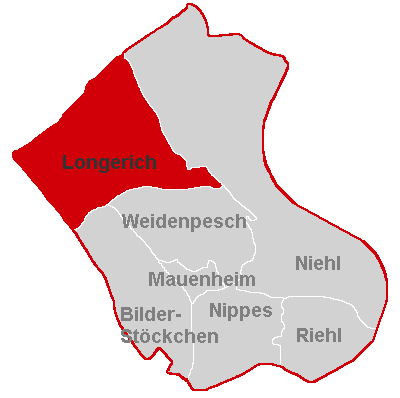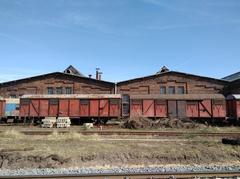
Longerich Cologne Germany Visiting Hours, Tickets, and Historical Sites Guide
Date: 15/06/2025
Introduction: The Historical Heart of Longerich in Cologne
Located on the left bank of the Rhine within Cologne’s Nippes borough, Longerich—known affectionately as “Lunke”—is a district where ancient roots meet vibrant community life. Rich in history, Longerich traces its beginnings to the Roman era and has evolved through the Middle Ages and into the modern urban landscape. Visitors to this area can explore a unique blend of Roman heritage, medieval architecture, and 20th-century developments, all set among lush parks and a welcoming neighborhood spirit (ferienwohnung-koeln.com, de.wikipedia.org).
Longerich’s significance is rooted in its strategic location on historical trade and military routes. Evidence of Roman settlement is found in both archaeological remains and linguistic traces. The district’s medieval heart is epitomized by the neo-Gothic St. Dionysius Church, a key architectural and cultural site (mapcarta.com).
Today, Longerich offers a harmonious blend of historical attractions, traditional farmsteads, community festivals, and green spaces. With easy access via the S11 S-Bahn and other public transit options, it provides an authentic, community-focused alternative to the city’s busier tourist hubs. Most sites—including St. Dionysius—welcome visitors with generous hours and free entry, making Longerich both convenient and enriching for history enthusiasts and casual travelers alike (Cologne Tourism, Cologne City Archive).
This comprehensive guide delivers historical context, practical travel tips, and insider knowledge—ensuring you make the most of your visit to one of Cologne’s most authentic and storied districts.
Guide Overview
- Discover Longerich: Historic Highlights
- Roman origins and medieval heritage
- From French to Prussian administration
- Industrialization and urban growth
- 20th-century transformations
- Visiting Longerich: Practical Information
- Getting there and around
- Key sites, hours, accessibility, and tours
- Best times to visit and events
- Attractions and Points of Interest
- St. Dionysius Church
- Longericher Hof
- Parks, local markets, and festivals
- Cultural Significance and Local Life
- Community traditions and identity
- Dining, accommodation, and etiquette
- Travel Tips and FAQs
- Planning your visit and staying connected
Discover Longerich: A Historic District in Cologne
Early Origins and Roman Influence
Longerich’s name, derived from early forms like “Lunrike,” reflects its Roman roots, marked by the suffix “-iacum” (ferienwohnung-koeln.com). The area developed along a vital Roman road connecting Cologne and Neuss, serving as a support point for the ancient city of Colonia Claudia Ara Agrippinensium (latlon-europe.com). While only limited Roman artifacts have been unearthed, this strategic location shaped Longerich’s historical trajectory (de.wikipedia.org).
Medieval and Ecclesiastical Heritage
Documented after 900 AD, Longerich emerged as a rural parish centered on St. Dionysius Church. The current neo-Gothic building, dating to 1899, is a testament to the district’s enduring religious and architectural significance (mapcarta.com). The church serves as both a spiritual and community hub.
Evolution through the Modern Era
During the French occupation (1794–1815), Longerich underwent administrative reforms that persisted into the Prussian period. The district’s boundaries shifted in 1886, distinguishing it from neighboring Nippes, Mauenheim, and Riehl (en.wikipedia.org). The arrival of the railway in 1855 spurred suburban growth, while 20th-century developments such as the “Old Garden City North” and post-war reconstruction projects further transformed the area (ferienwohnung-koeln.com).
Historical Background of Longerich
From Rural Village to Urban District
First officially recorded in 1003 CE, Longerich originated as a narrow settlement along a trade route, its name reflecting the Old High German terms for “long realm” (Cologne City Archive). For centuries, it was an agricultural village supplying Cologne with produce.
Annexed to Cologne in 1888, Longerich experienced significant infrastructural improvement and population growth. The extension of tram and rail lines tied the district closely to the city center, facilitating its modern transformation.
World War II brought destruction, but Longerich retained much of its historic character. Post-war expansion introduced residential neighborhoods, schools, and community facilities, balancing urban development with remnants of rural heritage.
Cultural Significance and Local Life
Community Traditions and Identity
Longerich prides itself on a strong community identity, fostered through local clubs, the Bürgerverein Longerich, and annual events like Karneval. The district’s Karneval celebrations, though smaller than those in central Cologne, are deeply rooted in local tradition (Cologne Carnival).
Architectural Heritage
The Romanesque St. Dionysius Church and surviving half-timbered farmhouses are highlights, offering insight into Longerich’s medieval and agrarian past. These are complemented by post-war residential blocks, illustrating the area’s layered history.
Green Spaces and Recreation
Longerich boasts ample green areas, including Longericher Park and allotment gardens, providing space for recreation and reflection. Its proximity to the Nippeser Tälchen and Cologne’s northern green belt further enhances its appeal (Cologne Green Spaces).
Attractions and Points of Interest
St. Dionysius Church
A centerpiece of the district, St. Dionysius Church offers a rich historical and architectural experience. Its neo-Gothic design, stained glass, and tranquil cemetery make it a must-see.
- Visiting Hours: Tuesday–Sunday, 10:00–17:00; closed Mondays.
- Tickets: Free; donations appreciated.
- Guided Tours: Weekends and by appointment via the Cologne Tourism Board.
Longericher Hof and Historic Farmsteads
Historic farmsteads like Longericher Hof now host community centers and restaurants, blending Rhineland architecture with local cuisine.
- Hours: Daily, 11:00–22:00.
- Entry: Free; dining charges apply.
Markets, Parks, and Festivals
- Longericher Wochenmarkt: Wednesday and Saturday mornings at the central square, featuring regional produce.
- Longericher Park: Open daily, dawn to dusk; free entry.
- Blücherpark: Nearby, with a lake, lawns, and seasonal events.
- Longericher Schützenfest: Early summer marksmen’s festival with parades and local food (Cologne Events).
- Karneval: Local parades and festivities leading up to Rosenmontag (Cologne Carnival).
Practical Visitor Tips
Getting There and Around
Longerich is easily reached via the S11 S-Bahn and tram line 15, connecting to Cologne’s center in 15–20 minutes. There is ample street parking and dedicated bike paths (Cologne by Bike), with route maps available online.
Accommodation
While Longerich has limited hotels, guesthouses and apartment rentals offer a peaceful stay. Central Cologne accommodations are easily accessible (Cologne Accommodation).
Dining and Local Cuisine
Sample Rhineland specialties at local taverns: Himmel un Ääd, Rheinischer Sauerbraten, and Kölsch beer are local favorites (Kölsch Beer).
Safety and Etiquette
Longerich is safe and welcoming. Basic precautions are advised in crowded spaces (Cologne Safety). Greet locals with “Hallo” or “Guten Tag,” and respect neighborhood quiet hours.
Cultural Insights
Demographics and Local Life
Longerich is home to families, professionals, and a growing international community. Sports clubs, schools, and community centers foster active engagement.
Sports and Recreation
Attend a handball match at Longericher SC (Longericher SC), or explore cycling and walking trails connecting to Cologne’s green belt (Cologne Cycling).
Religious and Multicultural Sites
- Moschee Longerich: Open for visitors on special occasions, offering insight into local Islamic traditions (Cologne Religious Sites).
FAQs
Q: What are the visiting hours for St. Dionysius Church?
A: Tuesday–Sunday, 10:00–17:00; closed Mondays.
Q: Are there entry fees for parks and historic sites?
A: No, most are free; donations appreciated.
Q: How do I get to Longerich from central Cologne?
A: Take the S11 S-Bahn or tram line 15 (15–20 minutes).
Q: Are guided tours available?
A: Yes, book via the Cologne Tourism Board.
Q: Is Longerich accessible for those with mobility needs?
A: Yes, major sites and transport are wheelchair accessible (Cologne Public Transport).
Recommendations for Your Visit
- Explore by foot or bike to uncover Longerich’s hidden gems and green spaces.
- Join a local festival for an immersive cultural experience.
- Visit St. Dionysius Church to appreciate the district’s medieval heritage.
- Enjoy Kölsch beer at a traditional tavern.
For updated events, maps, and travel resources, consult the Cologne Tourism Board and Cologne City Archive.
Visiting St. Dionysius Church: Hours, Tickets, and Local Tips
St. Dionysius Church is a historic and architectural highlight of Longerich, featuring neo-Gothic design, stained glass, and a welcoming community atmosphere. It opens its doors:
- Monday–Saturday: 9:00–18:00
- Sunday: 10:00–19:00 (hours may vary on religious holidays)
- Entry: Free; donations welcome
- Guided Tours: Available by request, with English options upon advance booking
The church is wheelchair accessible and easily reachable by public transport. While in the area, enjoy traditional cuisine at local pubs, stroll through Longericher Park, and participate in community events, especially during Karneval and summer festivals.
For more, visit the official St. Dionysius website or Cologne Tourism.
Summary: Key Points & Traveler Tips
Longerich offers a captivating blend of Roman and medieval history, community spirit, and green spaces. From the neo-Gothic St. Dionysius Church to vibrant markets and festivals, the district is ideal for travelers seeking authenticity and tranquility. With excellent public transport connections and free access to major attractions, Longerich is both accessible and rewarding. For the latest updates, download the Audiala app and stay connected with local tourism resources.
Sources & Further Reading
- Visiting Longerich: History, Attractions, and Travel Tips for Cologne’s Historic District, 2025, Ferienwohnung-Koeln (https://www.ferienwohnung-koeln.com/en/koeln/longerich)
- Longerich (Köln), Wikipedia, 2025 (https://de.wikipedia.org/wiki/Longerich_(K%C3%B6ln))
- History of Cologne, Latlon Europe, 2025 (https://latlon-europe.com/cologne/en/history_T05.htm)
- Districts of Cologne, Wikipedia, 2025 (https://en.wikipedia.org/wiki/Districts_of_Cologne)
- Historical Background of Longerich, 2025, Cologne City Archive (https://www.e-a-a.com/historical-archive-of-the-city-of-cologne-cologne-germany/)
- Cologne Tourism, 2025 (https://www.cologne-tourism.com/)
- Cologne City History, 2025 (https://www.cologne.de/)
- Cologne Parks, 2025 (https://www.stadt-koeln.de/leben-in-koeln/freizeit-natur-sport/parks/)
- Cologne Markets, 2025 (https://www.cologne-tourism.com/)
- Cologne Gastronomy, 2025 (https://www.cologne-tourism.com/)
- Cologne Events, 2025 (https://www.cologne-tourism.com/)
- Longericher SC, 2025 (https://www.lsc-koeln.de/)
- Cologne Cycling, 2025 (https://www.stadt-koeln.de/leben-in-koeln/verkehr/fahrrad/)
- Cologne Public Transport, 2025 (https://www.kvb.koeln/)
- Visiting St. Dionysius Church in Longerich, Cologne, 2025, Official Church Website and Cologne Tourism (https://www.st-dionysius-koeln.de, https://www.cologne-tourism.com/)






































































